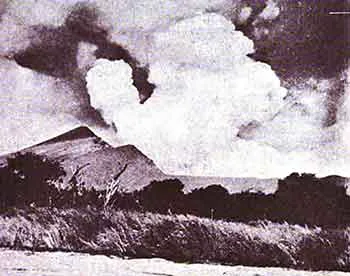The Barely Documented 1885 Taal Volcano Eruption
There is an eruption of Taal Volcano in Batangas that is scantily — if at all — documented. This is the one of 1885, an event that was not even included in a list of the volcano’s eruptions published in a flyer released in 2010 by the Philippine Institute of Volcanology and Seismology (PHIVOLCS)1. The list enumerated eruptions from 1572 to 1878 in the 19th century, but the next eruption listed was already the one from the main crater in 1903.
Curiously, the Spanish-born Jesuit Fr. Miguel Saderra-Maso, assigned to work at the Manila Observatory, in his 1911 publication2 about the same year’s eruption of Taal Volcano, failed to include the 1885 eruption in his own list as well. His work must have been the reference for the aforementioned PHIVOLCS flyer, albeit Saderro-Maso’s list skipped from 1878 to 1904 instead of 1903.
 |
| A view of the 1911 Taal Volcano eruption. Image digitally extracted from the 1911 publication "Taal Volcano, Album of Views." |
Volcano Discovery, a web site that informs and educates “students, earthquake enthusiasts and volcano aficionados on the wealth and relevant information3” regarding volcanoes, lists the 1885 eruption but affixes a question mark (?) next to the year as though it doubts the veracity of its own information4.
However, an 1888 paper5 by an English-born priest and naturalist by the name of Julian Tenison-Woods, who traveled extensively during the 19th century around East and Southeast Asia and wrote many papers about information he collected during his travels, provides some details about this heretofore neglected 1885 eruption of Taal Volcano.
Tenison-Woods first visited Lake Bombon6 and the volcano itself in March 1885, when the latter, as he wrote “had subsided into a state of repose as great, almost, as ever has been known.” This state of repose, however, would not remain for very long. There would be an eruption in September of 1885.
It was because of this eruption that Tenison-Woods, although able to visit Lake Bombon in March of 1886, “was unable to land upon the [volcano] island.” He wrote that while in September 1885 there “had been a severe eruption,” it was not accompanied “with such loss of life as in the historical disturbance in 1754.” Nonetheless, he noted that “there was considerable destruction of property.”
He went on to describe the destruction:
Unlike the 1911 eruption of the volcano during which as many as 1,300 victims were killed, many “in the act of fleeing7,” fortuitously in 1885, inhabitants of the crater island and other localities within range of the volcano’s wrath “had sought safety in flight, leaving their herds and their crops which were nearly all destroyed.”
By March 1886, when Tenison-Woods visited Lake Bombon for the second time, Taal Volcano was still emitting “very considerable quantities of white smoke with noises and explosions” and “the emission of ashes and stones was still quite perceptible.” Because of this, the priest concluded that it was unsafe to approach the volcano.
2 “The Eruption of Taal Volcano: January 30, 1911,” by Rev. Miguel Saderra Maso, S.J., published 1911 by the Department of the Interior Weather Bureau.
3 “About this Web Site,” online at Volcano Discovery.
4 “Taal Volcano,” online at Volcano Discovery.
5 “On the Volcano of Taal,” by the Rev. J.E. Tenison-Woods, published 1888 in the Australian journal “Proceedings of the Linnean Society of New South Wales,” online at the Internet Archive.
6 “Lake Bombon” was the old name of Taal Lake. 7 Saderra-Maso. Op cit.
